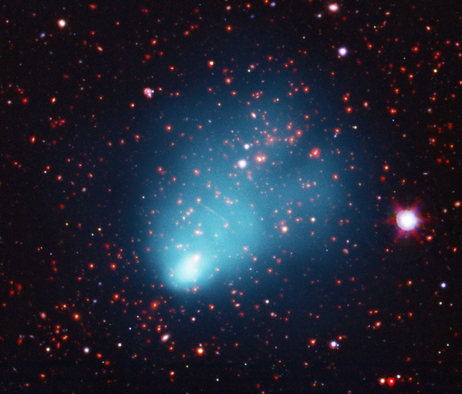



 The Kepler mission to discover new planets, which there is a blog post about a few posts down, has come up with some incredile results. A confirmed 11 planetary systems that host 26 planets, previously unknown, have been found. This doubles the number of confirmed planets found by Kepler and gives us new insight to how other planetary systems work, esspecially ones compact as these.. More then half of the newly discovered planets are around the size of Earth, and every single one of them is closer to their star then Venus is to our sun. The planetary system with the most exoplanets is Kepler-33, which has five Earth sized planets. Kepler discovers these systems using light detection, noticing when the light from a star is changed. This occurs when an orbiting planet passes in front of it. Once they suspect Kepler has found a planet they focus all of their resources and time to verifying it was a planet instead of some other space mass.
The Kepler mission to discover new planets, which there is a blog post about a few posts down, has come up with some incredile results. A confirmed 11 planetary systems that host 26 planets, previously unknown, have been found. This doubles the number of confirmed planets found by Kepler and gives us new insight to how other planetary systems work, esspecially ones compact as these.. More then half of the newly discovered planets are around the size of Earth, and every single one of them is closer to their star then Venus is to our sun. The planetary system with the most exoplanets is Kepler-33, which has five Earth sized planets. Kepler discovers these systems using light detection, noticing when the light from a star is changed. This occurs when an orbiting planet passes in front of it. Once they suspect Kepler has found a planet they focus all of their resources and time to verifying it was a planet instead of some other space mass. So, you guys know Snoopy from "Penuts"?
So, you guys know Snoopy from "Penuts"? Snoopy's connection with NASA actually began before Apollo 10. In 1968, NASA chose the beagle as an icon who would quote: "Emphasize mission success and act as a 'watchdog' for flight safety."
 |
| Illustration of Kepler 35b |
 |
| Kepler 34b |
 'El Gordo,' Galaxy With Mass 2 Quadrillion Times the Sun's, Discovered via NPR
'El Gordo,' Galaxy With Mass 2 Quadrillion Times the Sun's, Discovered via NPR As you can see, a habitable zone occupied by a solid planet is exceedingly rare. Most solar system's zones are far beyond their farthest planet, or so close to the star that the planets are frigid. As a species, our space programs allow us to shout into the void, calling out for reassurance that we aren't the only intelligent life in the universe. Even physicist Steven Hawking says it would be foolish to think we are alone in such a gargantuan space.
As you can see, a habitable zone occupied by a solid planet is exceedingly rare. Most solar system's zones are far beyond their farthest planet, or so close to the star that the planets are frigid. As a species, our space programs allow us to shout into the void, calling out for reassurance that we aren't the only intelligent life in the universe. Even physicist Steven Hawking says it would be foolish to think we are alone in such a gargantuan space.  By Gracie Currier-Tait
By Gracie Currier-TaitA study published in the journal Nature, and featured at the American Astronomical Society's conference shows that most of our stars in the Milky Way, have planets. That being said, there are many stars in our galaxy, and scientists suggest there are a lot more planets out there.
About 100 billion to be exact.
Found through the article Astronomers See More Planets Than Stars in Galaxy from Pj Star, astronomers are beginning to fathom just how many planets could be out there.
One study in Nature estimates that for every star in the Milky Way, it averages at least 1.6 planets per star. Astronomers use different techniques and tools to estimate just how many planets are out there. We have confirmed over 700 exoplanets (planets outside our solar system), while thousands remain un-confirmed.Astronomers are discovering a plethora of other interesting discoveries, such as the Star Wars-eque planet with two suns, or the miniature star system with its own tiny sun and dwarf planets. "We're finding an exciting potpourri of things we didn't even think could exist," said Harvard University astronomer Lisa Kaltenegger.
I personally find this to be fascinating. Although we have very little knowledge about our galaxy, I am all for the belief in the infinite and unknown. The idea of there maybe being 100 billion planets in our small patch of space is unbelievable... I'll be interested in finding out what other planets are out there.